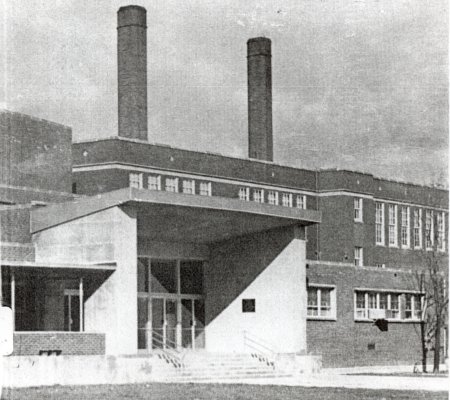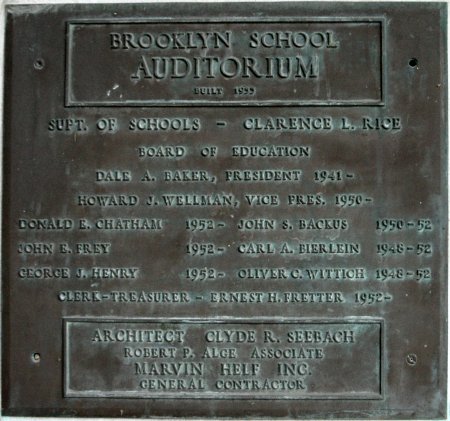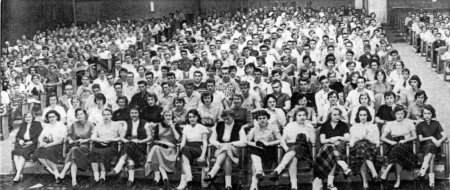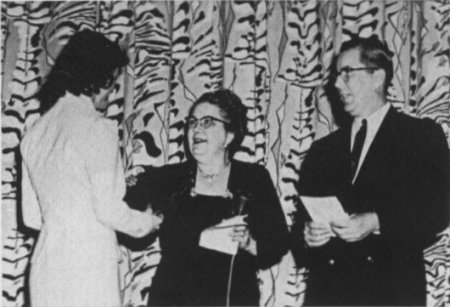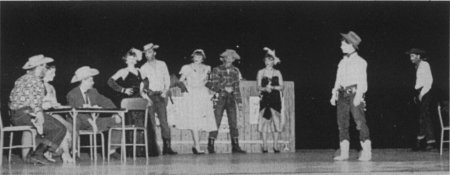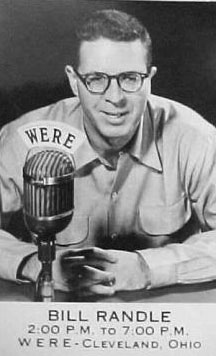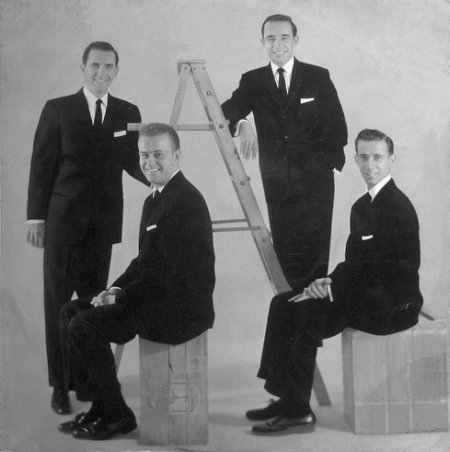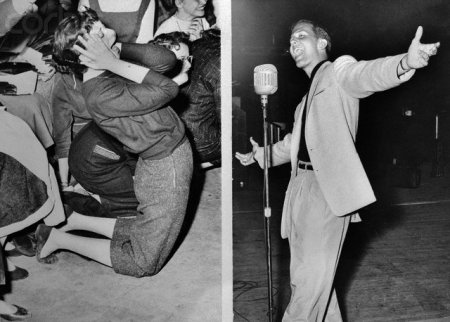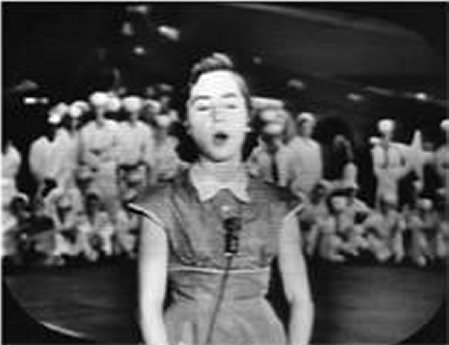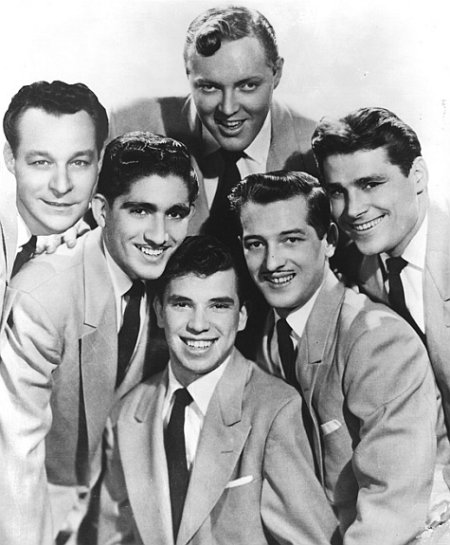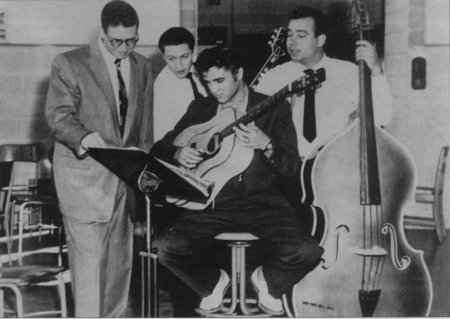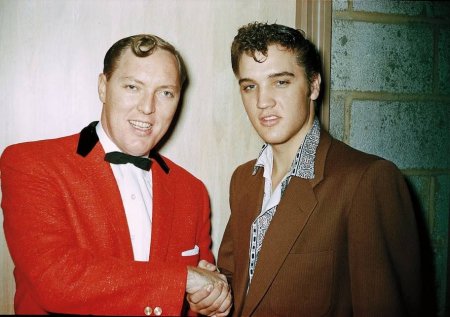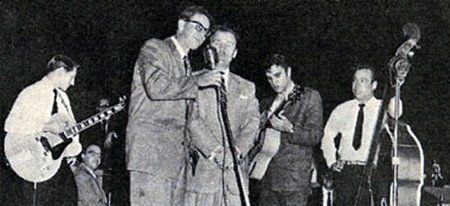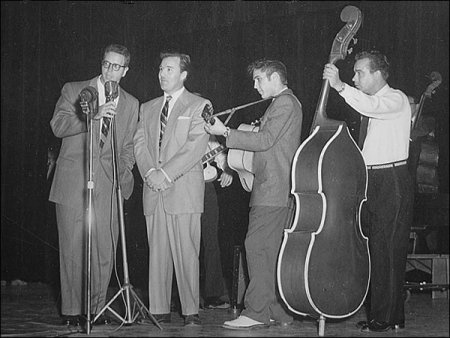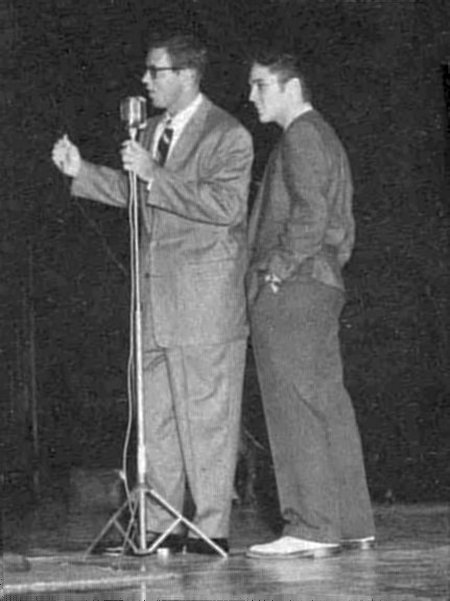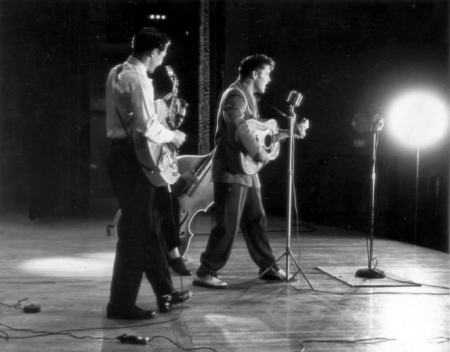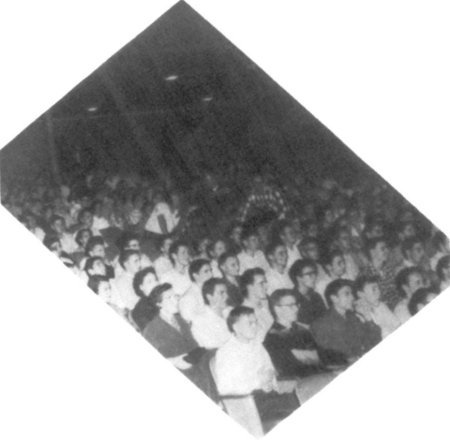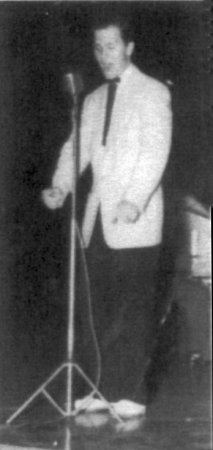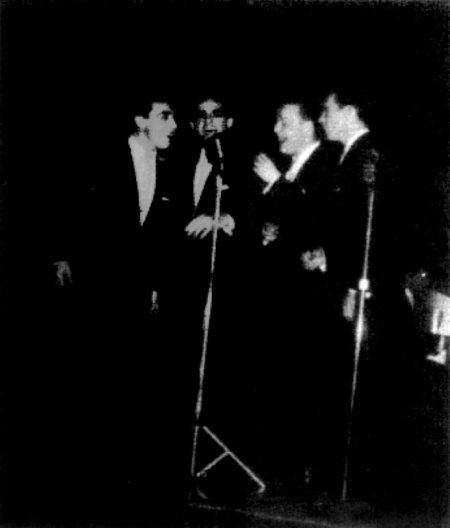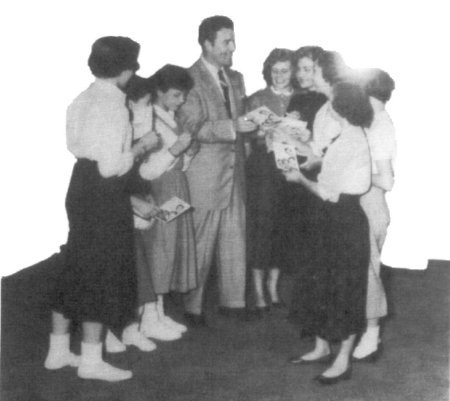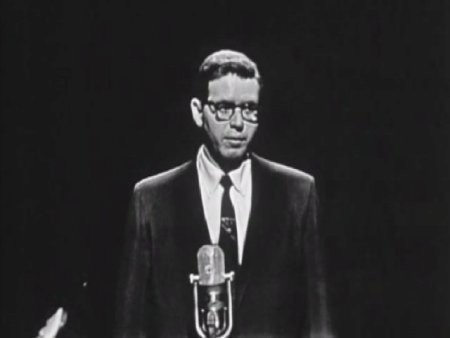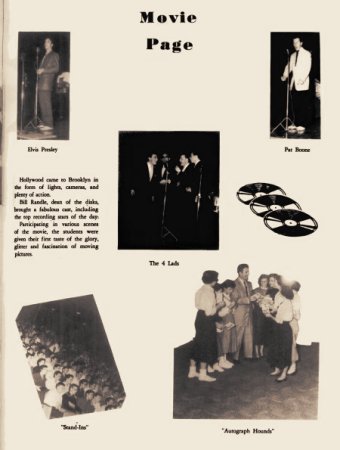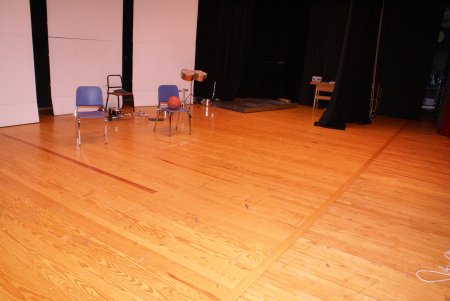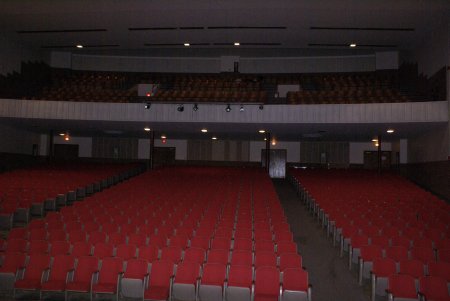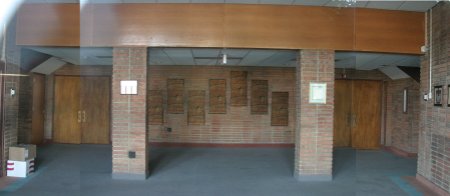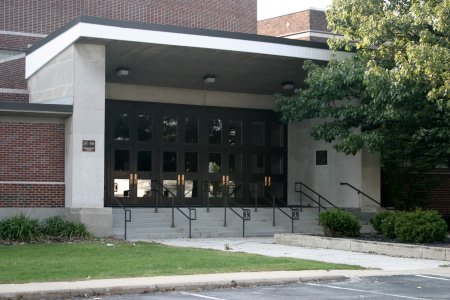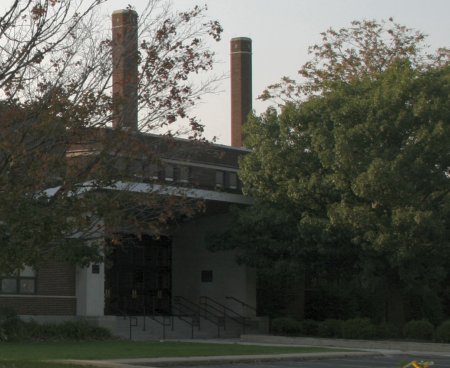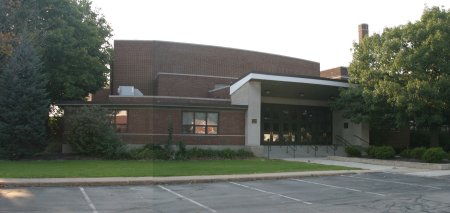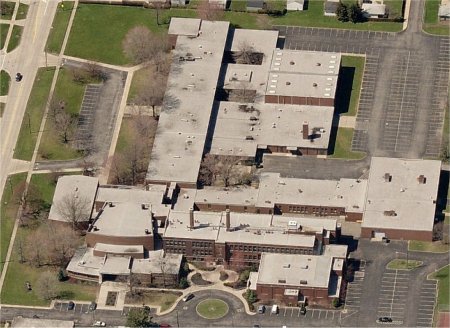 |
Brooklyn School Auditorium
The city of Brooklyn in Northeast Ohio is located six miles southwest of downtown Cleveland. "Brooklyn township," was organized June 1, 1818 and embraced originally "all that part of Cleveland situated on the west side of the Cuyahoga River, except the farm owned by Alfred Kelly." Brooklyn's boundaries were the City of Cleveland and Lake Erie on the North, the townships of Parma and Independence on the south, the City of Cleveland and Newburgh township on the east and the township of Rockport on the west. The portion of Brooklyn Township which is now the City of Brooklyn became a village on March 26, 1927 and was charted as a city in 1952.1
In 1955, construction was completed on a new auditorium for Brooklyn's High School at 9700 Biddulph Rd., the only high school in the Brooklyn City School District. Prior to that the gymnasium doubled for use as its auditorium. Including the balcony, the auditorium seats about 900 people, almost double the size of the, then, entire student body at approximately 500. Brooklyn High's principal at the time was John K. Nieman and the Superintendent of Schools was Clarence L. Rice, who had his office near the balcony of the auditorium. Rice commissioned curtains for the auditorium made from fabric with a pattern designed by Salvador Dali called "Spring Rain."
In addition to the use by the school's drama department, the Brooklyn stage saw occasional use for performances and sock hops sponsored by WERE Cleveland's disc jockeys Bill Randle and Tommy Edwards. "We disk jockeys couldn't get into Cleveland schools. They had a restriction. But we went all over the suburbs, all the way to Perry and Madison. We did a lot of CYO stuff, too," said Edwards. "Sometimes I did four shows a day, starting out at 10 in the morning. I must have spent $1,000 a week. But that’s what helped me get the ratings," Randle said.2
Randle, at the time, in addition to broadcasting five hours every weekday for WERE also hosted a Saturday-morning show for CBS in New York. During 1955-56, he had the highest rating of any radio performer and a Time Magazine story on him was headlined "Top Jock." He had contracted with Universal Pictures to produce a short documentary film, about himself, and planned to film certain performers in concert with an audience first in the Cleveland area and then later in New York with Nat King Cole and other stars.2 For the Cleveland portion he held a radio contest where the winning school was treated to the concert. Clementine Kulyk, a freshman in 1955, remembers helping collect signatures from students that helped Brooklyn HS win the contest. It didn't hurt that Randle was also a friend of Principal Nieman who was receptive to assemblies and that the new auditorium afforded the proper lighting and sound to benefit the filming.3 On October 20, 1955, Randle brought The Four Lads, Pat Boone, Bill Haley and the Comets, Priscilla Wright and Elvis, Scotty and Bill to Brooklyn High School to perform and film. D.J., by now playing drums regularly with Elvis had been incapacitated for several weeks recovering from gallbladder surgery causing him to unfortunately miss more than a few gigs and not make the trip.
The Four Lads began as a singing quartet from Toronto in 1950 and were discovered by Mitch Miller of Columbia Records in 1951 who saw them performing at the Le Ruban Bleu, a posh dinner club in New York. He had them back Johnnie Ray on his early 50's hits "Cry" and "The Little White Cloud That Cried" the success of which led to their own contract followed soon by a number of pop Top 100 hits of their own, including "The Mockingbird," "Skokian," "Moments to Remember" and "Istanbul." 4
Charles Eugene Patrick (Pat) Boone graduated high school in Nashville in 1953 and soon after eloped with his classmate, country star Red Foley's daughter, Shirley. He made his first recording in 1954 on Republic Records and appeared on Arthur Godfrey's Talent show and then The Ted Mack Amateur Hour which led to a contract with Dot Records in 1955. Pat thought that he would be singing ballads in the style of Perry Como but Dot producer Randy Wood had him record "Two Hearts, Two Kisses", a cover of an R&B song by The Charms, which went to number sixteen. His next record, a cover of Fats Domino's "Ain't That A Shame", along with Fats' version entered the charts in July of 1955 with Domino's reaching number ten, and Pat's going to number one.5 By 1955 Pat had also started becoming a regular on CBS television's "Arthur Godfrey and His Friends."
At only fourteen years old, Canadian singer Priscilla Wright had a hit single, "The Man in The Raincoat," in 1955 which led to several appearances in North America including one on Ed Sullivan's show on CBS 6. The show, still called "Toast of the Town," wasn't renamed the Ed Sullivan Show until September 18, 1955. She appeared on the July 3, 1955 show which was broadcast live from the deck of the aircraft carrier USS Antietam anchored in the Hudson River that week and featured The Chordettes, of "Mr. Sandman" fame that night.7 The following April, Elvis, Scotty, Bill and DJ would also perform televised from an aircraft carrier. Strangely, there was no mention of Priscilla's performance at the Brooklyn High auditorium in any of the interviews and articles of Bill Randle or Tommy Edwards regarding that time. Several students though do remember her appearance and her wearing a raincoat when she performed. Priscilla remembers attending the Circle theater performance the previous evening also and sharing a limo with Pat Boone to St. Michael's Hall for the evening performances later that day.
Originally a Country and Western band, "Bill Haley and the Saddlemen," formed in 1949 and changed their name to "Bill Haley and the Comets" in 1952. Pioneers of Rock and Roll, they originally recorded "Rock Around The Clock" in 1954 which saw only a little success. They then had a hit with Big Joe Turner's "Shake Rattle and Roll" and then saw "Rock Around the Clock" go to number one the following year in 1955 with a reissue after it was used in the movie "Blackboard Jungle." By the time of their appearance at the Brooklyn High School they had already made their first national television performance on The Ed Sullivan Show, on August 7, 1955.8 Tommy Edwards had met them the year before on a promo tour and believed that this appearance and the one later that night at St. Michael's were the only times Haley performed in Cleveland.9 Of the five acts, Elvis was the least known, especially to the students at Brooklyn, where he opened the show. He was also the only one without some sort of CBS affiliation though Randle and others had been pitching him to Mitch Miller who on behalf of Columbia Records had asked Bob Neal for a price for his contract from Sam Phillips. Randle had also been dealing with Hill and Range, song publishers of the BMI family who specialized in "partnership publishing." They had expressed interest in Elvis as early as May of 55 and desired to recruit Randle to start a talent management company which would likely have had Randle end up as Elvis' manager. It was no secret that rumors were about that Sam Phillips was entertaining offers to sell Elvis' contract and Randle thought Elvis' inclusion in the movie might come in handy in the marketing of Elvis' contract.10
Tommy Edwards had booked Elvis, Scotty and Bill for a return performance at the Circle theater the previous night, which is were Randle first met them on their first appearance in the North the previous February and had suggested them for an audition (unsuccessful) on Arthur Godfrey's Talent scouts. Randle had been playing their records in Cleveland since January and still thinking he had spotted a winner, he plugged the "sensational young singer" (Presley) in his Oct. 1, 1955, newspaper column, "Randle on Record," as the singer "whose style is a combination of hillbilly nasalties, rock ’n’ roll, Johnnie Ray and a peculiar sound all his own. The new phenomenon looks like Tony Curtis and drives a pink and black Cadillac. Watch him roar."2
Prior to the show at the Brooklyn Auditorium, Tommy Edwards took a photo of Bill and Elvis backstage. The Brooklyn appearance was not the first time that Bill Haley had shared a stage with Elvis, Scotty and Bill. Earlier in October the Colonel, not yet managing Elvis, had approached Haley's manager to team Bill and the Comets with a Hank Snow tour, which Elvis, Scotty and Bill joined in Oklahoma City on the 16th. They had missed each other by a day in days prior in Lubbock, TX, where each of their acts were opened by Buddy Holly. The Colonel's objective was to get Elvis more exposure and appear more lucrative to RCA who were also interested in his contract.10
Priscilla Wright remembers meeting Arthur Cohen, the director of Bill's film the night before at the Circle Theater and of hearing something about union difficulties. Cohen's credits to date, according to the Internet movie database were as a writer, director and producer of a series of shorts for Universal. According to Randle: “He thought he was ‘pitiful,’ completely unacceptable, not worth the time and effort to set up the numbers. I told him about the phenomenal response Presley was getting . . . but Cohen was adamant.10 Bill then arranged to pay the cameraman, Jack Barnett, the overtime out of his pocket to film Elvis. He contracted with the local Musician's Union for a backup band. According to Jane Scott of the Cleveland Plain Dealer, she saw checks for $230 to Cohen, $200 to Barnett and a $600 check to conductor pianist Wendell Tracy for the musicians. The Musicians Union contract called for a "stage show plus movie film and sound production for an 18-minute movie" at Brooklyn High School from 1 to 4 p.m.2 John Gelardi, a freshmen at the time, remembers the camera and crew set up in the center rear section of the theater below the balcony and the crew resembling an "old time movie crew with beret style hats and caps on backwards".
Pat Boone, just twenty-one years old, never forgot the occasion of his first meeting with Elvis Presley. I had lived in Texas, and I had seen his name on some country jukeboxes, and I wondered how in the world a hillbilly could be the next big thing, especially with a name like Elvis Presley. So I was curious, and sure enough, at the high school auditorium where we did this thing, he came backstage, and already he had a little entourage [probably Red and his cousin Gene]. Now, nobody in Cleveland had ever heard of him, so the fact that he had an entourage struck me as funny. I went over dressed in my button-down collar and thin tie and white buck shoes and introduced myself. He mumbled something I couldn't understand, leaned back against the wall with his head down, and never looked me in the eye. So, I said, ‘Boy, Bill Randle thinks you’re really going to be big,' and he said, "Mmm . . .mrrrbbllee ..., ’ sort of a country twang mumble. I just couldn’t tell what he was saying. He had his shirt collar turned up, and his hair was real greasy, and it was, well, he was always looking down, you know, like he couldn’t look up. I thought to myself, what's the matter with this guy? I thought his performance would be a catastrophe, that he’d pass out onstage or something." 10
Priscilla vividly remembers standing backstage with Elvis as they waited for their respective turns on stage, "I can still see him, as he walked on stage, how he turned into that incredible performer. I remember Bill Haley and his Comets, performing with his bass upside down - first and only time I've seen that !"
Boone’s fears were not realized. When Elvis hit the stage he looked to Boone like he had just gotten off a motorcycle. He had his shirt open, and he looked like he was laughing at something, like he had some private joke, you know? He didn’t say anything, just went into some rockabilly type song, and the kids loved it. I was really surprised. Then he opened his mouth and said something, and it was so hillbilly that he lost the crowd. Then he sang another song and won them over again. As long as he didn’t talk, he was okay. It took me a long time to win that crowd." 10
In 1980, Cleveland Plain Dealer reporter Jane Scott wrote, "Brooklyn High School Principal William T. Hall, then a teacher, remembers the enthusiasm of the students. Athletic director Henry C. Joy held the doors to keep the students away from Pat Boone and the Four Lads. "It seems to me that the kids were more turned on by Boone than Presley," recalled Joseph Garn, assistant principal. Guidance counselor Helen Hurst Scheau remembers that day, too. "I sat in the second row. I’m afraid I wasn‘t too impressed with Presley. But I remember his bright pink glittery suit." So does James E. Heege, now a managing engineer for Ohio Bell. 'Probably because the suit seemed a little out of place at that time. I was backstage turning lights on and off. We were more excited about Pat Boone.' Sgt. Dennis Yurik of the Brooklyn Police Department might have been in that movie. The cameraman took his picture in study hall. 'I was really interested in Bill Haley, but I can still picture Presley’s pink suit,' he said. Actually, Presley had a red suit, but the lights made it look pink. He wore white buck shoes because he wanted to look like Pat Boone, Randle remembered." 2
With the student body at around 500, the inclusion of faculty, staff and members of the PTA, there probably weren't more than around 600 people that actually saw the show that afternoon. Former PTA president Betty Rauch remembers that day well, "We had a PTA board meeting here, and Mr. Nieman always sat in on it. He told us we were going to have this assembly with Pat Boone, Bill Haley and the Comets, and the Four Lads, and if we wanted to sit up in the balcony, we were welcome. So the whole PTA board came and sat in on it. And when Elvis came out in that orange suit . . . He was a shocker when he got up there. You didn’t see people wiggle like that back then." With just a hint of a swoon in her voice, Joanne Miller, a student at the time said "Oh he looked good. He was very good looking with his hair slicked back, tight pants, and this orange suit." In addition to the newly released "Mystery Train," Elvis performed, "That’s All Right," "Blue Moon of Kentucky," "Good Rockin' Tonight" and " I Forgot to Remember to Forget." 3
Rauch, Miller and Pat Smith, a fellow classmate who was also part of the audience that day remembered that all they did was talk about the young performer after he left the stage. "Everyone asked, ‘Who is he?' ‘What is he?' " Elvis' brand of music was strange — it was blues, it was country, and it was performed in a way that stunned his audience. He was definitely different. 3 Joyce Harrison, another student remembers walking home with her friends talking about his red jacket, trying to decide if it was red or orange. Elvis actually wore a brown jacket initially backstage and changed to red for the performance. Bill Haley and The Comets all wore red too.
Backstage, Randle introduced Elvis to Mike Stewart, a big bear of a man who had been very successful in managing the Four Lads and would one day take over the United Artists label. Stewart reputedly called Mitch Miller at Columbia Records the following day adding to the chorus of praise that Randle had started and that Miller clearly wished would go away.10 Stewart though, was not very impressed with Elvis. Bernie Toorish of The Four Lads said Stewart dismissed him as "just a flash in the pan." 11 Randle would later say that Stewart told him that he would ruin his career with him.12 Elvis, Scotty and Bill had their latest recording out from Sun, "Mystery Train." Tommy Edwards sold 45's in the lobby and passed out souvenir photos of the acts to the students. Later that night the acts, at the very least Pat Boone, along with Elvis, Scotty and Bill performed again at St. Michael's. Filming was said to have been done there also though Scotty doesn't recall cameras being there. Edwards, written up in Billboard magazine as the first disc jockey in the country to have a newsletter, wrote in the T. E. Newsletter on Oct. 21, 1955: "This has been quite a week for me, what with the Grand Ole Opry in town and appearing in Bill Randle's short movie subject. 2
In the Saturday, October 22, 1955, edition of the Cleveland Press, in Bill Randle’s column, was an item called "Turn-table Topics," which read: "Turning my life into a frenzy this week was a shooting company from Universal International Pictures. I’m not a Gable at acting, so I’m fortunate to be supported in this film short by Pat Boone, the Four Lads, Bill Haley and his Comets, and the phenomenal Elvis Presley. Called 'Top jock,' the film will run about 15 minutes when it hits your movie house." 10 On the very same day as the show, Gladys and Vernon Presley signed a telegram provided by Tom Diskin granting the Colonel "sole and exclusive" representation of their son with respect to "all negotiations" for a new recording contract. Diskin's accompanying message seeks to reassure the Presleys that they are in the "most competent hands." 13 Four days later, on October 24, the Colonel contacted Sam Phillips, informing him of his new managerial status and demanding that he name his "best flat price for complete dissolution free and clear of the talent and recording services of Elvis Presley." 10 The following month Elvis' contract was bought by RCA.
On January, 28, 1956, just over 3 months after the performance at Brooklyn High, Elvis, Scotty, Bill and D.J. made their first national appearance on network television. Bill Randle was there and introduced them, or rather Elvis, saying, "We'd like at this time to introduce you to a young fellow who like many performers, Johnnie Ray among them, come up out of nowhere to be overnight very big stars. This young fellow we saw for the very first time while making a movie short, we think tonight that he's going to make television history for you. We'd like you to meet him now, Elvis Presley! and here he is..." The New York portion of filming never happened. "Union jurisdiction problems came up between the Hollywood and New York film crews. CBS didn't want to get involved in union difficulties — all their stall were union — and the film was canceled," Randle said. Of the Cleveland footage, Bill said "I showed it myself at a Euclid Shore Junior High School assembly. And I showed clips of it on WEWS Channel 5 in 1956, as well as some Las Vegas footage I had taken of Elvis." 2 Around the time that the Brooklyn class of 1956 was preparing for graduation, Parker signed Elvis for a Hal Wallis Paramount film, "Love Me Tender," with the stipulation that any previous films of Presley 'would be legally enjoined.' And at that pinpoint in time, the Elvis Presley, Pat Boone, Bill Haley and the Comets and the Four Lads film 'disappeared,'" Randle said. 2
The yearbook for the class of 56 only briefly mentioned the concert and filming. Bill Haley and the Comets were not mentioned at all. Three short sentences read, "Hollywood came to Brooklyn in the form of lights, cameras and plenty of action. Bill Randle, dean of the disks, brought a fabulous cast, including the top recording stars of the day. Participating in various scenes of the movie, the students were given their first taste of glory, glitter and the fascination of moving pictures." 2 Surprisingly enough, the yearbooks have become highly sought after collector items. Even the copies at the High School and local libraries have turned up missing. The Brooklyn Historical Society Museum keeps theirs locked up.
Randle also brought other acts to assemblies at the High school, like Eydie Gorme and the Everly brothers before leaving full time radio in the 60s to pursue higher education.3 In September of 1958, 524 high school students started classes in the new Brooklyn High School built adjacent to the rear of the old one while 247 junior high students occupied the old school.
Priscilla Wright, though offered a contract in 1955, was forced to postpone her singing career by her parents for several years and did not return to performing until the mid 1980s.6 The Four Lads earned their last Gold record in 1956. Through the years some members changed and they broke up in 1977. In 1984 Bernie Toorish resurrected the band and has continued to perform to this day though he is the only original member from the '50s lineup.4 From the end of 1954 until the end of 1956, Bill Haley and The Comets placed nine singles into the top twenty, one at number one and three more in the top ten, though three of the original members left the band at the end of 1955. They were already well into their 30s by the time they charted and by 1959 were not placing singles or albums anywhere near the top of the charts. Bill saw a resurgence of interest in his music in the '70s before he passed away in 1981 at the age of 55.14 From 1955 to 1962 Pat Boone had fifty-four hit singles and for four consecutive years, 1955 to 1959, he was never off the pop charts. During that time, only Elvis sold more records.5
As for the film, commonly referred to now as "The Pied Piper of Cleveland," it has since been shrouded in myth and confusion and the existence of which the subject of much debate. Jack Barnett, who shot the movie, died in 1967 and Arthur Cohen, the director, died in 1968. In 1980 Jane Scott wrote that Randall figures he spent $4,000 for the Brooklyn High film, $7,000 for the Las Vegas one and around $20 ,000 setting up the canceled New York shots. "During the course of a production, you can hire someone to do other work. I hired the cameraman, director and stars to do the Brooklyn High show. I paid them. There is no doubt in my mind that that segment is mine. "What I did legally was actually pay for — and own the rights to — that particular segment of the film being done for Universal. They shot certain things; I shot certain things.2
In 1992, an article in People magazine reported that after killing the short, Universal had reputedly stored the film in canisters marked A DAY IN THE LIFE OF A FAMOUS DJ, and that over the years Bill established ownership and copyright in his name. The article stated the he then sold it sight unseen to a British production company for $1.9 million whose parent company, PolyGram, in turn bought the film for $2.2 million.
The story takes an interesting and even more confusing twist when mistaken associations were made. Ray Santilli, an independent producer in the UK, bought film from a cameraman in Cleveland in the summer of 1993 who had reputedly shot footage of Elvis at an outdoor concert for Universal news. The cameraman then arranged to sell him footage from "The, reputed, Roswell Alien Autopsy." Confusing things even more, when grilled about the legitimacy of the autopsy footage, Santilli, in order to protect the identity of the cameraman gave his name as that of Jack Barnett, Randle's cinematographer. In short, Randle's footage from the Brooklyn concert in 1955 to this day remains unseen and lost. Bill's 1956 Las Vegas footage survives and portions have been used in the documentary "Elvis 56." Bill Randle passed the Ohio State Bar exams at the age of sixty four and practiced law for sixteen years. He also returned part-time to radio in the 1990s, anchoring an early morning show on WRMR Cleveland before passing away in 2004. The following year a 50th anniversary benefit show was held at Brooklyn's auditorium on October 22, 2005.
The Anniversary benefit featured performances by members of the Comets, the Four Lads and Priscilla Wright, who had all participated in the performances there fifty years earlier. The stage floor at the high school had been replaced sometime prior and wide wooden frames made from sections of the old stage were made to frame composite posters of the reunion show in 2005. They were given to area donors who had subsidized the 2005 benefit concert.
The Rock and Roll Hall of Fame in Cleveland designated the High School as a rock and roll Landmark in October of 1998. Today the High School and the old school, now occupied by the Middle school, both share the address of 9200 Biddulph Rd. The school's drama department has always been very active and produces several plays in the auditorium each year.
One final note to be added is that several mysterious unexplained events and mishaps in the auditorium over the years has led many to believe it to be haunted. Some say its haunted by the ghost of a janitor while others say its the ghost of Clarence L. Rice but whether its superstition or just a tradition that's been carried over the years, Chris Kaspar, the set director, will confirm that permission is still asked of whatever apparition on the first day of a new production to insure no "super-natural" interference.
page added April 10, 2009 Special thanks to April Georgius and Chris Kaspar of the Brooklyn High School, to Barbara Stepic and John Gelardi of the Brooklyn Historical Society Museum for their assistance with this page, and to Priscilla Wright for her input. Be sure to check out 1950s Radio in Color: The Lost Photographs of Deejay Tommy Edwards. 1
excerpt from "Cuyahoga County History of 1879"courtesy
Brooklyn
Historical Society Museum |
|
All photos on this site (that we didn't borrow) unless otherwise indicated are the property of either Scotty Moore or James V. Roy and unauthorized use or reproduction is prohibited. |
